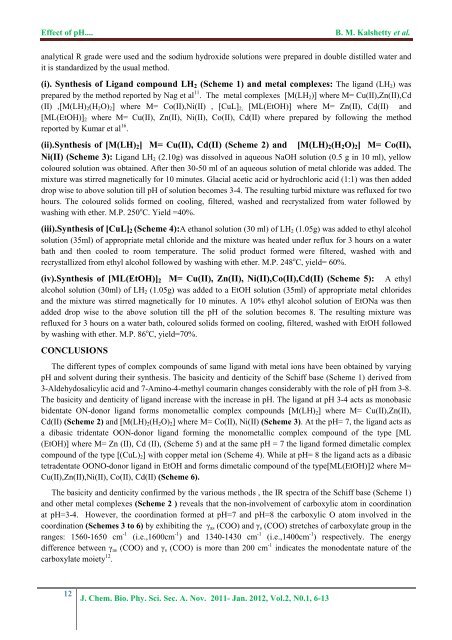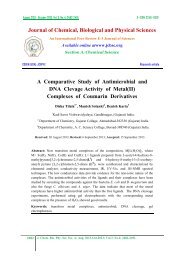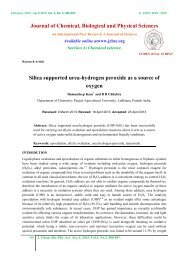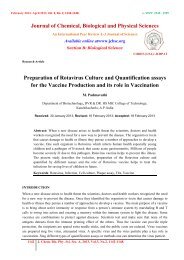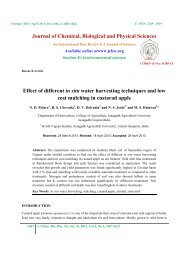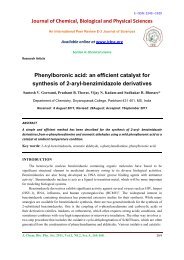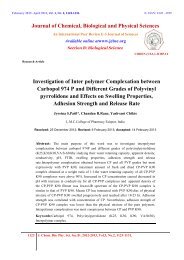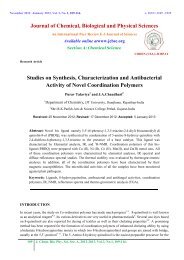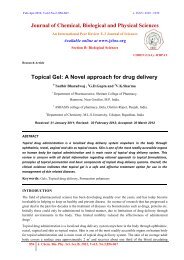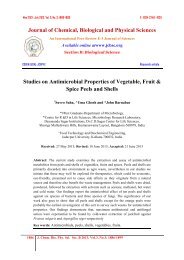Effect of pH on the formation of complex compounds with Schiff ...
Effect of pH on the formation of complex compounds with Schiff ...
Effect of pH on the formation of complex compounds with Schiff ...
You also want an ePaper? Increase the reach of your titles
YUMPU automatically turns print PDFs into web optimized ePapers that Google loves.
<str<strong>on</strong>g>Effect</str<strong>on</strong>g> <str<strong>on</strong>g>of</str<strong>on</strong>g> <str<strong>on</strong>g>pH</str<strong>on</strong>g>....B. M. Kalshetty et al.analytical R grade were used and <strong>the</strong> sodium hydroxide soluti<strong>on</strong>s were prepared in double distilled water andit is standardized by <strong>the</strong> usual method.(i). Syn<strong>the</strong>sis <str<strong>on</strong>g>of</str<strong>on</strong>g> Ligand compound LH 2 (Scheme 1) and metal <strong>complex</strong>es: The ligand (LH 2 ) wasprepared by <strong>the</strong> method reported by Nag et al 11 . The metal <strong>complex</strong>es [M(LH 2 )] where M= Cu(II),Zn(II),Cd(II) ,[M(LH) 2 (H 2 O) 2 ] where M= Co(II),Ni(II) , [CuL] 2, [ML(EtOH)] where M= Zn(II), Cd(II) and[ML(EtOH)] 2 where M= Cu(II), Zn(II), Ni(II), Co(II), Cd(II) where prepared by following <strong>the</strong> methodreported by Kumar et al 16 .(ii).Syn<strong>the</strong>sis <str<strong>on</strong>g>of</str<strong>on</strong>g> [M(LH) 2 ] M= Cu(II), Cd(II) (Scheme 2) and [M(LH) 2 (H 2 O) 2 ] M= Co(II),Ni(II) (Scheme 3): Ligand LH 2 (2.10g) was dissolved in aqueous NaOH soluti<strong>on</strong> (0.5 g in 10 ml), yellowcoloured soluti<strong>on</strong> was obtained. After <strong>the</strong>n 30-50 ml <str<strong>on</strong>g>of</str<strong>on</strong>g> an aqueous soluti<strong>on</strong> <str<strong>on</strong>g>of</str<strong>on</strong>g> metal chloride was added. Themixture was stirred magnetically for 10 minutes. Glacial acetic acid or hydrochloric acid (1:1) was <strong>the</strong>n addeddrop wise to above soluti<strong>on</strong> till <str<strong>on</strong>g>pH</str<strong>on</strong>g> <str<strong>on</strong>g>of</str<strong>on</strong>g> soluti<strong>on</strong> becomes 3-4. The resulting turbid mixture was refluxed for twohours. The coloured solids formed <strong>on</strong> cooling, filtered, washed and recrystalized from water followed bywashing <strong>with</strong> e<strong>the</strong>r. M.P. 250 o C. Yield =40%.(iii).Syn<strong>the</strong>sis <str<strong>on</strong>g>of</str<strong>on</strong>g> [CuL] 2 (Scheme 4):A ethanol soluti<strong>on</strong> (30 ml) <str<strong>on</strong>g>of</str<strong>on</strong>g> LH 2 (1.05g) was added to ethyl alcoholsoluti<strong>on</strong> (35ml) <str<strong>on</strong>g>of</str<strong>on</strong>g> appropriate metal chloride and <strong>the</strong> mixture was heated under reflux for 3 hours <strong>on</strong> a waterbath and <strong>the</strong>n cooled to room temperature. The solid product formed were filtered, washed <strong>with</strong> andrecrystallized from ethyl alcohol followed by washing <strong>with</strong> e<strong>the</strong>r. M.P. 248 o C, yield= 60%.(iv).Syn<strong>the</strong>sis <str<strong>on</strong>g>of</str<strong>on</strong>g> [ML(EtOH)] 2 M= Cu(II), Zn(II), Ni(II),Co(II),Cd(II) (Scheme 5): A ethylalcohol soluti<strong>on</strong> (30ml) <str<strong>on</strong>g>of</str<strong>on</strong>g> LH 2 (1.05g) was added to a EtOH soluti<strong>on</strong> (35ml) <str<strong>on</strong>g>of</str<strong>on</strong>g> appropriate metal chloridesand <strong>the</strong> mixture was stirred magnetically for 10 minutes. A 10% ethyl alcohol soluti<strong>on</strong> <str<strong>on</strong>g>of</str<strong>on</strong>g> EtONa was <strong>the</strong>nadded drop wise to <strong>the</strong> above soluti<strong>on</strong> till <strong>the</strong> <str<strong>on</strong>g>pH</str<strong>on</strong>g> <str<strong>on</strong>g>of</str<strong>on</strong>g> <strong>the</strong> soluti<strong>on</strong> becomes 8. The resulting mixture wasrefluxed for 3 hours <strong>on</strong> a water bath, coloured solids formed <strong>on</strong> cooling, filtered, washed <strong>with</strong> EtOH followedby washing <strong>with</strong> e<strong>the</strong>r. M.P. 86 o C, yield=70%.CONCLUSIONSThe different types <str<strong>on</strong>g>of</str<strong>on</strong>g> <strong>complex</strong> <strong>compounds</strong> <str<strong>on</strong>g>of</str<strong>on</strong>g> same ligand <strong>with</strong> metal i<strong>on</strong>s have been obtained by varying<str<strong>on</strong>g>pH</str<strong>on</strong>g> and solvent during <strong>the</strong>ir syn<strong>the</strong>sis. The basicity and denticity <str<strong>on</strong>g>of</str<strong>on</strong>g> <strong>the</strong> <strong>Schiff</strong> base (Scheme 1) derived from3-Aldehydosalicylic acid and 7-Amino-4-methyl coumarin changes c<strong>on</strong>siderably <strong>with</strong> <strong>the</strong> role <str<strong>on</strong>g>of</str<strong>on</strong>g> <str<strong>on</strong>g>pH</str<strong>on</strong>g> from 3-8.The basicity and denticity <str<strong>on</strong>g>of</str<strong>on</strong>g> ligand increase <strong>with</strong> <strong>the</strong> increase in <str<strong>on</strong>g>pH</str<strong>on</strong>g>. The ligand at <str<strong>on</strong>g>pH</str<strong>on</strong>g> 3-4 acts as m<strong>on</strong>obasicbidentate ON-d<strong>on</strong>or ligand forms m<strong>on</strong>ometallic <strong>complex</strong> <strong>compounds</strong> [M(LH) 2 ] where M= Cu(II),Zn(II),Cd(II) (Scheme 2) and [M(LH) 2 (H 2 O) 2 ] where M= Co(II), Ni(II) (Scheme 3). At <strong>the</strong> <str<strong>on</strong>g>pH</str<strong>on</strong>g>= 7, <strong>the</strong> ligand acts asa dibasic tridentate OON-d<strong>on</strong>or ligand forming <strong>the</strong> m<strong>on</strong>ometallic <strong>complex</strong> compound <str<strong>on</strong>g>of</str<strong>on</strong>g> <strong>the</strong> type [ML(EtOH)] where M= Zn (II), Cd (II), (Scheme 5) and at <strong>the</strong> same <str<strong>on</strong>g>pH</str<strong>on</strong>g> = 7 <strong>the</strong> ligand formed dimetalic <strong>complex</strong>compound <str<strong>on</strong>g>of</str<strong>on</strong>g> <strong>the</strong> type [(CuL) 2 ] <strong>with</strong> copper metal i<strong>on</strong> (Scheme 4). While at <str<strong>on</strong>g>pH</str<strong>on</strong>g>= 8 <strong>the</strong> ligand acts as a dibasictetradentate OONO-d<strong>on</strong>or ligand in EtOH and forms dimetalic compound <str<strong>on</strong>g>of</str<strong>on</strong>g> <strong>the</strong> type[ML(EtOH)]2 where M=Cu(II),Zn(II),Ni(II), Co(II), Cd(II) (Scheme 6).The basicity and denticity c<strong>on</strong>firmed by <strong>the</strong> various methods , <strong>the</strong> IR spectra <str<strong>on</strong>g>of</str<strong>on</strong>g> <strong>the</strong> <strong>Schiff</strong> base (Scheme 1)and o<strong>the</strong>r metal <strong>complex</strong>es (Scheme 2 ) reveals that <strong>the</strong> n<strong>on</strong>-involvement <str<strong>on</strong>g>of</str<strong>on</strong>g> carboxylic atom in coordinati<strong>on</strong>at <str<strong>on</strong>g>pH</str<strong>on</strong>g>=3-4. However, <strong>the</strong> coordinati<strong>on</strong> formed at <str<strong>on</strong>g>pH</str<strong>on</strong>g>=7 and <str<strong>on</strong>g>pH</str<strong>on</strong>g>=8 <strong>the</strong> carboxylic O atom involved in <strong>the</strong>coordinati<strong>on</strong> (Schemes 3 to 6) by exhibiting <strong>the</strong> γ as (COO) and γ s (COO) stretches <str<strong>on</strong>g>of</str<strong>on</strong>g> carboxylate group in <strong>the</strong>ranges: 1560-1650 cm -1 (i.e.,1600cm -1 ) and 1340-1430 cm -1 (i.e.,1400cm -1 ) respectively. The energydifference between γ as (COO) and γ s (COO) is more than 200 cm -1 indicates <strong>the</strong> m<strong>on</strong>odentate nature <str<strong>on</strong>g>of</str<strong>on</strong>g> <strong>the</strong>carboxylate moiety 12 .12J. Chem. Bio. Phy. Sci. Sec. A. Nov. 2011- Jan. 2012, Vol.2, N0.1, 6-13


